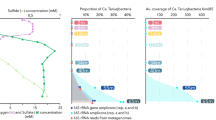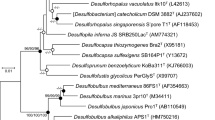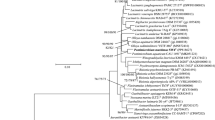Abstract
Planctomycetes are widely distributed in marine environments, where they supposedly play a role in carbon recycling. To deepen our understanding about the ecology of this sparsely studied phylum six planctomycete fosmids from two marine upwelling systems were investigated and compared with all available planctomycete genomic sequences including the as yet unpublished near-complete genomes of Blastopirellula marina DSM 3645T and Planctomyces maris DSM 8797T. High numbers of sulfatase genes (41–109) were found on all marine planctomycete genomes and on two fosmids (2). Furthermore, C1 metabolism genes otherwise only known from methanogenic Archaea and methylotrophic Proteobacteria were found on two fosmids and all planctomycete genomes, except for ‘Candidatus Kuenenia stuttgartiensis’. Codon usage analysis indicated high expression levels for some of these genes. In addition, novel large families of planctomycete-specific paralogs with as yet unknown functions were identified, which are notably absent from the genome of ‘Candidatus Kuenenia stuttgartiensis’. The high numbers of sulfatases in marine planctomycetes characterizes them as specialists for the initial breakdown of sulfatated heteropolysaccharides and indicate their importance for recycling carbon from these compounds. The almost ubiquitous presence of C1 metabolism genes among Planctomycetes together with codon usage analysis and information from the genomes suggest a general importance of these genes for Planctomycetes other than formaldehyde detoxification. The notable absence of these genes in Candidatus K. stuttgartiensis plus the surprising lack of almost any planctomycete-specific gene within this organism reveals an unexpected distinctiveness of anammox bacteria from all other Planctomycetes.
Similar content being viewed by others
Log in or create a free account to read this content
Gain free access to this article, as well as selected content from this journal and more on nature.com
or
Accession codes
Accessions
GenBank/EMBL/DDBJ
References
Asakawa S, Abe I, Kudoh Y, Kishi N, Wang Y, Kubota R et al. (1997). Human BAC library: construction and rapid screening. Gene 191: 69–79.
Badger JH, Olsen GJ . (1999). CRITICA: coding region identification tool invoking comparative analysis. Mol Biol Evol 16: 512–524.
Bauer M, Lombardot T, Teeling H, Ward NL, Amann RI, Glöckner FO . (2004). Archaea-like genes for C1-transfer enzymes in Planctomycetes: phylogenetic implications of their unexpected presence in this phylum. J Mol Evol 59: 571–586.
Bauld J, Staley JT . (1976). Planctomyces maris sp. nov.: a marine isolate of the Planctomycetes-Blastocaulis group of budding bacteria. J Gen Microbiol 97: 45–55.
Bauld J, Staley JT . (1980). Planctomyces maris sp. nov., nom. rev. Int J Syst Bact 30: 657.
Berteau O, Guillot A, Benjdia A, Rabot S . (2006). A new type of bacterial sulfatases reveals a novel maturation pathway in prokaryotes. J Biol Chem 281: 22464–22470.
Brochier C, Philippe H . (2002). Phylogeny: a non-hyperthermophilic ancestor for bacteria. Nature 417: 244.
Carbone A, Zinovyev A, Kepes F . (2003). Codon adaptation index as a measure of dominating codon bias. Bioinformatics 19: 2005–2015.
Cavalier-Smith T . (2006). Rooting the tree of life by transition analyses. Biol Direct 1: 19.
Chistoserdova L, Jenkins C, Kalyuzhnaya MG, Marx CJ, Lapidus A, Vorholt JA et al. (2004). The enigmatic planctomycetes may hold a key to the origins of methanogenesis and methylotrophy. Mol Biol Evol 21: 1234–1241.
Chistoserdova L, Rasche ME, Lidstrom ME . (2005). Novel dephosphotetrahydromethanopterin biosynthesis genes discovered via mutagenesis in Methylobacterium extorquens AM1. J Bacteriol 187: 2508–2512.
Chistoserdova L, Vorholt JA, Thauer RK, Lidstrom ME . (1998). C1 transfer enzymes and coenzymes linking methylotrophic bacteria and methanogenic Archaea. Science 281: 99–102.
Crump BC, Armbrust EV, Baross JA . (1999). Phylogenetic analysis of particle-attached and free-living bacterial communities in the Columbia river, its estuary, and the adjacent coastal ocean. Appl Environ Microbiol S 65: 3192–3204.
Delcher AL, Harmon D, Kasif S, White O, Salzberg SL . (1999). Improved microbial gene identification with GLIMMER. Nucleic Acids Res 27: 4636–4641.
DeLong EF, Franks DG, Alldredge AL . (1993). Phylogenetic diversity of aggregate-attached vs free-living marine bacterial assemblages. Limnol Oceanogr 38: 924–934.
Dierks T, Lecca MR, Schlotterhose P, Schmidt B, von Figura K . (1999). Sequence determinants directing conversion of cysteine to formylglycine in eukaryotic sulfatases. EMBO J 18: 2084–2091.
Fieseler L, Horn M, Wagner M, Hentschel U . (2004). Discovery of the novel candidate phylum ‘Poribacteria’ in marine sponges. Appl Environ Microbiol 70: 3724–3732.
Franzmann PD, Skerman VB . (1984). Gemmata obscuriglobus, a new genus and species of the budding bacteria. Antonie Van Leeuwenhoek 50: 261–268.
Fuerst JA, Gwilliam HG, Lindsay M, Lichanska A, Belcher C, Vickers JE et al. (1997). Isolation and molecular identification of planctomycete bacteria from postlarvae of the giant tiger prawn, Penaeus monodon. Appl Environ Microbiol 63: 254–262.
Fuerst JA, Sambhi SK, Paynter JL, Hawkins JA, Atherton JG . (1991). Isolation of a bacterium resembling Pirellula species from primary tissue culture of the giant tiger prawn (Penaeus monodon). Appl Environ Microbiol 57: 3127–3134.
Fuerst JA, Webb RI, Garson MJ, Hardy L, Reiswig HM . (1998). Membrane-bounded nucleoids in microbial symbionts of marine sponges. FEMS Microbiol Lett 166: 29–34.
Fuerst JA, Webb RI, Garson MJ, Hardy L, Reiswig HM . (1999). Membrane-bounded nuclear bodies in a diverse range of symbionts of great Barrier Reef sponges. Mem Queensl Mus 44: 193–203.
Fuerst JA . (1995). The planctomycetes: emerging models for microbial ecology, evolution and cell biology. Microbiology 141: 1493–1506.
Fuerst JA . (2005). Intracellular compartmentation in planctomycetes. Annu Rev Microbiol 59: 299–328.
Gade D, Schlesner H, Glöckner FO, Amann R, Pfeiffer S, Thomm M . (2004). Identification of planctomycetes with order-, genus-, and strain-specific 16S rRNA-targeted probes. Microb Ecol 47: 243–251.
Giovannoni SJ, Godchaux Wr, Schabtach E, Castenholz RW . (1987b). Cell wall and lipid composition of Isosphaera pallida, a budding eubacterium from hot springs. J Bacteriol 169: 2702–2707.
Giovannoni SJ, Schabtach E, Castenholz RW . (1987a). Isosphaera pallida, gen. and comb. nov., a gliding, budding eubacterium from hot springs. Arch Microbiol 147: 276–284.
Glöckner FO, Kube M, Bauer M, Teeling H, Lombardot T, Ludwig W et al. (2003). Complete genome sequence of the marine planctomycete Pirellula sp. strain 1. Proc Natl Acad Sci USA 100: 8298–8303.
Goenrich M, Bartoschek S, Hagemeier CH, Griesinger C, Vorholt JA . (2002). A glutathione-dependent formaldehyde-activating enzyme (Gfa) from Paracoccus denitrificans detected and purified via two-dimensional proton exchange NMR spectroscopy. J Biol Chem 277: 3069–3072.
Guo FB, Ou HY, Zhang CT . (2003). ZCURVE: a new system for recognizing protein-coding genes in bacterial and archaeal genomes. Nucleic Acids Res 31: 1780–1789.
Inagaki F, Nunoura T, Nakagawa S, Teske A, Lever M, Lauer A et al. (2006). Biogeographical distribution and diversity of microbes in methane hydrate-bearing deep marine sediments on the Pacific ocean margin. Proc Natl Acad Sci USA 103: 2815–2820.
Jetten MSM, Horn SJ, Van Loosdrecht MCM . (1997). Towards a more sustainable wastewater treatment system. Water SciTechnol 35: 171–180.
Jetten MSM, Schmid M, Schmidt I, Wubben M, van Dongen U, Abma W et al. (2002). Improved nitrogen removal by application of new nitrogen-cycle bacteria. Rev Environ Sci Biotechnol 1: 51–63.
Kalyuzhnaya MG, Bowerman S, Nercessian O, Lidstrom ME, Chistoserdova L . (2005c). Highly divergent genes for methanopterin-linked C1 transfer reactions in Lake Washington, assessed via metagenomic analysis and mRNA detection. Appl Environ Microbiol 71: 8846–8854.
Kalyuzhnaya MG, Korotkova N, Crowther G, Marx CJ, Lidstrom ME, Chistoserdova L . (2005b). Analysis of gene islands involved in methanopterin-linked C1 transfer reactions reveals new functions and provides evolutionary insights. J Bacteriol 187: 4607–4614.
Kalyuzhnaya MG, Lidstrom ME, Chistoserdova L . (2004). Utility of environmental primers targeting ancient enzymes: methylotroph detection in Lake Washington. Microb Ecol 48: 463–472.
Kalyuzhnaya MG, Nercessian O, Lapidus A, Chistoserdova L . (2005d). Fishing for biodiversity: novel methanopterin-linked C transfer genes deduced from the Sargasso Sea metagenome. Environ Microbiol 7: 1909–1916.
Kalyuzhnaya MG, Nercessian O, Lidstrom ME, Chistoserdova L . (2005a). Development and application of polymerase chain reaction primers based on fhcD for environmental detection of methanopterin-linked C1-metabolism in bacteria. Environ Microbiol 7: 1269–1274.
König E, Schlesner H, Hirsch P . (1984). Cell wall studies on budding bacteria of the Planctomyces/Pasteuria group and on a Prosthecomicrobium sp. Arch Microbiol 138: 200–205.
Krogh A, Larsson B, von Heijne G, Sonnhammer EL . (2001). Predicting transmembrane protein topology with a hidden Markov model: application to complete genomes. J Mol Biol S 305: 567–580.
Kuypers MM, Lavik G, Woebken D, Schmid M, Fuchs BM, Amann R et al. (2005). Massive nitrogen loss from the Benguela upwelling system through anaerobic ammonium oxidation. Proc Natl Acad Sci USA 102: 6478–6483.
Liesack W, König H, Schlesner H, Hirsch P . (1986). Chemical composition of the peptidoglycan-free cell envelopes of budding bacteria of the Pirellula/Planctomyces group. Arch Microbiol 145: 361–366.
Liesack W, Söller R, Steward T, Haas H, Giovannoni S, Stackebrandt E . (1992). The influence of tachytelically (rapidly) evolving sequences on the topology of phylogenetic trees—intrafamily relationships and the phylogenetic position of Planctomycetaceae as revealed by comparative analysis of 16S ribosomal RNA sequences. Syst Appl Microbiol 15: 357–362.
Lindsay MR, Webb R, Fuerst JA . (1997). Pirellulosomes: a new type of membrane-bounded cell compartment in planctomycete bacteria of the genus Pirellula. Microbiology 143: 739–748.
Lindsay MR, Webb RI, Strous M, Jetten MSM, Butler MK, Forde RJ et al. (2001). Cell compartmentalisation in planctomycetes: novel types of structural organisation for the bacterial cell. Arch Microbiol 175: 413–429.
Llobet-Brossa E, Rossello-Mora R, Amann R . (1998). Microbial community composition of Wadden Sea sediments as revealed by fluorescence in situ hybridization. Appl Environ Microbiol 64: 2691–2696.
Lombardot T, Bauer M, Teeling H, Amann R, Glöckner FO . (2005). The transcriptional regulator pool of the marine bacterium Rhodopirellula baltica SH 1T as revealed by whole genome comparisons. FEMS Microbiol Lett 242: 137–145.
Ludwig W, Strunk O, Westram R, Richter L, Meier H, Yadhukumar et al. (2004). ARB: a software environment for sequence data. Nucleic Acids Res 32: 1363–1371.
Marx CJ, Chistoserdova L, Lidstrom ME . (2003). Formaldehyde-detoxifying role of the tetrahydromethanopterin-linked pathway in Methylobacterium extorquens AM1. J Bacteriol 185: 7160–7168.
McCarren J, Delong EF . (2007). Proteorhodopsin photosystem gene clusters exhibit co-evolutionary trends and shared ancestry among diverse marine microbial phyla. Environ Microbiol S 9: 846–858.
Meyer F, Goesmann A, McHardy AC, Bartels D, Bekel T, Clausen J et al. (2003). GenDB—an open source genome annotation system for prokaryote genomes. Nucleic Acids Res 31: 2187–2195.
Miskin IP, Farrimond P, Head IM . (1999). Identification of novel bacterial lineages as active members of microbial populations in a freshwater sediment using a rapid RNA extraction procedure and RT-PCR. Microbiology 145: 1977–1987.
Morris RM, Longnecker K, Giovannoni SJ . (2006). Pirellula and OM43 are among the dominant lineages identified in an Oregon coast diatom bloom. Environ Microbiol 8: 1361–1370.
Musat N, Werner U, Knittel K, Kolb S, Dodenhof T, van Beusekom JE et al. (2006). Microbial community structure of sandy intertidal sediments in the North Sea, Sylt-Romo Basin, Wadden Sea. Syst Appl Microbiol 29: 333–348.
Neef A, Amann R, Schlesner H, Schleifer KH . (1998). Monitoring a widespread bacterial group: in situ detection of planctomycetes with 16S rRNA-targeted probes. Microbiology 144: 3257–3266.
Nielson H, Engelbrecht J, Brunak S, von Heijne G . (1997). Identification of prokaryotic and eukaryotic signal peptides and prediction of their cleavage sites. Protein Eng 10: 1–6.
Pace NR, Olsen GJ, Woese CR . (1986). Ribosomal RNA phylogeny and the primary lines of evolutionary descent. Cell S 45: 325–326.
Peden JF . (1999). Analysis of Codon Usage. PhD thesis, Department of Genetics, University of Nottingham.
Pimentel-Elardo S, Wehrl M, Friederich AB, Jensen PR, Henschel U . (2003). Isolation of planctomycetes from Aplysina sponges. Aquatic Microbial Ecol 33: 239–245.
Quast C . (2006). MicHanThi - design and implementation of a system for the prediction of gene functions in genome annotation projects. Master thesis (available on request).
Rabus R, Gade D, Helbig R, Bauer M, Glöckner FO, Kube M et al. (2002). Analysis of N-acetylglucosamine metabolism in the marine bacterium Pirellula sp. strain 1 by a proteomic approach. Proteomics 2: 649–655.
Rusch A, Huettel M, Reimers CE, Taghon GL, Fuller CM . (2003). Activity and distribution of bacterial populations in middle Atlantic bight shelf sands. FEMS Microbiol Ecol 44: 89–100.
Rusch DB, Halpern AL, Sutton G, Heidelberg KB, Williamson S, Yooseph S et al. (2007). The sorcerer II global ocean sampling expedition: Northwest Atlantic through Eastern Tropical Pacific. PLoS Biol S 5: e77.
Schlesner H, Rensmann C, Tindall BJ, Gade D, Rabus R, Pfeiffer S et al. (2004). Taxonomic heterogeneity within the Planctomycetales as derived by DNA-DNA hybridization, description of Rhodopirellula baltica gen. nov., sp. nov., transfer of Pirellula marina to the genus Blastopirellula gen. nov. as Blastopirellula marina comb. nov. and emended description of the genus Pirellula. Int J Syst Evol Microbiol 54: 1567–1580.
Schlesner H . (1994). The development of media suitable for the microorganisms morphologically resembling Planctomyces spp., Pirellula spp., and other Planctomycetales from various aquatic habitats using dilute media. Syst Appl Microbiol 17: 135–145.
Schmid M, Twachtmann U, Klein M, Strous M, Juretschko S, Jetten MSM et al. (2000). Molecular evidence for genus level diversity of bacteria capable of catalyzing anaerobic ammonium oxidation. Syst Appl Microbiol 23: 93–106.
Scott JW, Rasche ME . (2002). Purification, overproduction, and partial characterization of beta-RFAP synthase, a key enzyme in the methanopterin biosynthesis pathway. J Bacteriol S 184: 4442–4448.
Sinninghe Damsté JS, Strous M, Rijpstra WI, Hopmans EC, Geenevasen JA, van Duin AC et al. (2002). Linearly concatenated cyclobutane lipids form a dense bacterial membrane. Nature S 419: 708–712.
Stackebrandt E, Ludwig W, Schubert W, Klink F, Schlesner H, Roggentin T et al. (1984). Molecular genetic evidence for early evolutionary origin of budding peptidoglycan-less eubacteria. Nature 307: 735–737.
Staley JT, Bouzek H, Jenkins C . (2005). Eukaryotic signature proteins of Prosthecobacter dejongeii and Gemmata sp. Wa-1 as revealed by in silico analysis. FEMS Microbiol Lett 243: 9–14.
Stein JL, Marsh TL, Wu KY, Shizuya H, DeLong EF . (1996). Characterization of uncultivated prokaryotes: isolation and analysis of a 40-kilobase-pair genome fragment from a planktonic marine archaeon. J Bacteriol S 178: 591–599.
Strous M, Fuerst JA, Kramer EH, Logemann S, Muyzer G, van de Pas-Schoonen KT et al. (1999). Missing lithotroph identified as new planctomycete. Nature 400: 446–449.
Strous M, Pelletier E, Mangenot S, Rattei T, Lehner A, Taylor MW et al. (2006). Deciphering the evolution and metabolism of an anammox bacterium from a community genome. Nature 440: 790–794.
Studholme DJ, Fuerst JA, Bateman A . (2004). Novel protein domains and motifs in the marine planctomycete Rhodopirellula baltica. FEMS Microbiol Lett 236: 333–340.
Teeling H, Lombardot T, Bauer M, Ludwig W, Glöckner FO . (2004). Evaluation of the phylogenetic position of the planctomycete ‘Rhodopirellula baltica’ SH 1 by means of concatenated ribosomal protein sequences, DNA-directed RNA polymerase subunit sequences and whole genome trees. Int J Syst Evol Microbiol 54: 791–801.
Tekniepe BL, Schmidt JM, Starr MP . (1981). Life cycle of a budding and appendaged bacterium belonging to morphotype IV ofthe Blastocaulis-Planctomyces group. Curr Microbiol 5: 1–6.
Vergin KL, Urbach E, Stein JL, DeLong EF, Lanoil BD, Giovannoni SJ . (1998). Screening of a fosmid library of marine environmental genomic DNA fragments reveals four clones related to members of the order Planctomycetales. Appl Environ Microbiol 64: 3075–3078.
Vorholt JA, Chistoserdova L, Stolyar SM, Thauer RK, Lidstrom ME . (1999). Distribution of tetrahydromethanopterin-dependent enzymes in methylotrophic bacteria and phylogeny of methenyl tetrahydromethanopterin cyclohydrolases. J Bacteriol 181: 5750–5757.
Vorholt JA, Kalyuzhnaya MG, Hagemeier CH, Lidstrom ME, Chistoserdova L . (2005). MtdC, a novel class of methylene tetrahydromethanopterin dehydrogenases. J Bacteriol 187: 6069–6074.
Wagner M, Horn M . (2006). The Plantomycetes, Verrucomicrobia, Chlamydiae and sister phyla comprise a superphylum with biotechnological and medical relevance. Curr Opin Biotechnol 17: 241–249.
Wallner SR, Bauer M, Würdemann C, Wecker P, Glöckner FO, Faber K . (2005). Highly enantioselective sec-alkyl sulfatase activity of the marine planctomycete Rhodopirellula baltica shows retention of configuration. Angew Chem Int Ed Engl 44: 6381–6384.
Wang J, Jenkins C, Webb RI, Fuerst JA . (2002). Isolation of Gemmata-like and Isosphaera-like planctomycete bacteria from soil and freshwater. Appl Environ Microbiol 68: 417–422.
Weisburg WG, Hatch TP, Woese CR . (1986). Eubacterial origin of Chlamydiae. J Bacteriol 167: 570–574.
Woese CR . (1987). Bacterial evolution. Microbiol Rev S 51: 221–271.
Zhou J, Bruns MA, Tiedje JM . (1996). DNA recovery from soils of diverse composition. Appl Environ Microbiol S 62: 316–322.
Acknowledgements
The Gordon and Betty Moore Foundation (www.moore.org) has funded the almost complete sequencing of B. marina DSM 3645T and P. maris DSM 8797T within the framework of their Marine Microbiology Initiative. Furthermore, EFD is funded by a grant from the Gordon and Betty Moore foundation. Analysis of Rhodopirellula baltica SH 1T is supported by the European Union through the Network of Excellence Marine Genomics Europe. Sequencing of G obscuriglobus UQM 2246T is a collaboration between the group of Naomi Ward at The Institute for Genomic Research (www.tigr.org) and the group of John A. Fuerst at the University of Queensland, Australia and has been funded by the DOE (DoE grant DEFC0295ER61962). This study was funded by the Max Planck Society.
Author information
Authors and Affiliations
Corresponding author
Additional information
Supplementary Information accompanies the paper on The ISME Journal website (http://www.nature.com/ismej)
Rights and permissions
About this article
Cite this article
Woebken, D., Teeling, H., Wecker, P. et al. Fosmids of novel marine Planctomycetes from the Namibian and Oregon coast upwelling systems and their cross-comparison with planctomycete genomes. ISME J 1, 419–435 (2007). https://doi.org/10.1038/ismej.2007.63
Received:
Revised:
Accepted:
Published:
Issue date:
DOI: https://doi.org/10.1038/ismej.2007.63
Keywords
This article is cited by
-
Life on the edge: active microbial communities in the Kryos MgCl2-brine basin at very low water activity
The ISME Journal (2018)
-
Diversity patterns and isolation of Planctomycetes associated with metalliferous deposits from hydrothermal vent fields along the Valu Fa Ridge (SW Pacific)
Antonie van Leeuwenhoek (2018)
-
The Paradigms They Are a-Changin’: past, present and future of PVC bacteria research
Antonie van Leeuwenhoek (2018)
-
Patterns of bacterial diversity in the marine planktonic particulate matter continuum
The ISME Journal (2017)
-
Comparative metagenomics of hydrocarbon and methane seeps of the Gulf of Mexico
Scientific Reports (2017)



